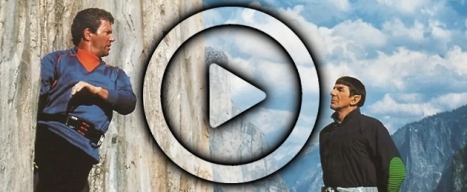This June, we’re taking a look at some classic Star Trek movie tie-ins and other interesting objects. Check back daily for the latest reviews and retrospectives.
The late eighties and early nineties saw a change in the world of Star Trek tie-ins. During the eighties, tie-in writers had typically been afforded a great deal of freedom in telling their stories – allowed to explore the fringes of the Star Trek universe with little regard to how things matched up. The period saw a number of truly spectacular Star Trek tie-ins that count among the best work ever released with the Star Trek brand on it – John Ford’s The Final Reflection or Diane Duane’s My Enemy, My Ally.
However, with the release of Star Trek V: The Final Frontier and the broadcast of the third season of Star Trek: The Next Generation, there was a shift in how the franchise approached tie-in novels and comic books. Gene Roddenberry had arguably lost control of his creation, with the Harve Bennett and Nicholas Meyer taking control of the feature films while Rick Berman and Michael Piller were the driving creative forces on the television show.

Crossing swords…
As such, the tie-ins became a place where Roddenberry and his “people” – including Richard Arnold and Susan Sackett – could make their influence most heavily felt. So, in the late eighties and early nineties, a conscious effort was made to re-tool the novels and the comic book tie-ins, with Richard Arnold maintaining a much tighter grip on the reigns. DC’s first volume of Star Trek comics was cancelled after fifty-six issues, and another volume was launched to coincide with the launch of the Next Generation comic.
Writer Peter David had closed out the first volume of the Star Trek comic, and was drafted in as the writer of the new on-going series. However, he almost immediately came into conflict with Richard Arnold. Pages of the first issue had to be hastily re-drawn when Richard Arnold vetoed the use of a supporting character from Star Trek: The Animated Series, after the comic had been drawn. In many respects, this set the tone for the comic, which was victim to all sorts of weird editorial mandates.

The Andorian Incident…
While writer Michael Jan Friedman remained the writer on the on-going Next Generation comic for most of its run – only occasionally getting another writer to fill in – Peter David departed the Star Trek comic before the end of the book’s second year on the stand. This is especially frustrating when one considers the pedigree of Peter David. An accomplished novelist and comic book writer, David had a wealth of experience in the medium that was being maliciously squandered by Arnold.
It’s a shame, because the opening twelve issues of DC’s second volume of Star Trek make for a delightful read and a fitting substitute for a live-action Star Trek television show unfolding between the movies.

Warp speed ahead…
Continue reading →
Filed under: Comics, The Original Series | Tagged: continuity, dc comics, kirk, klingons, peter david, richard arnold, star trek, Star Trek V: The Final Frontier, the final frontier | Leave a comment »























